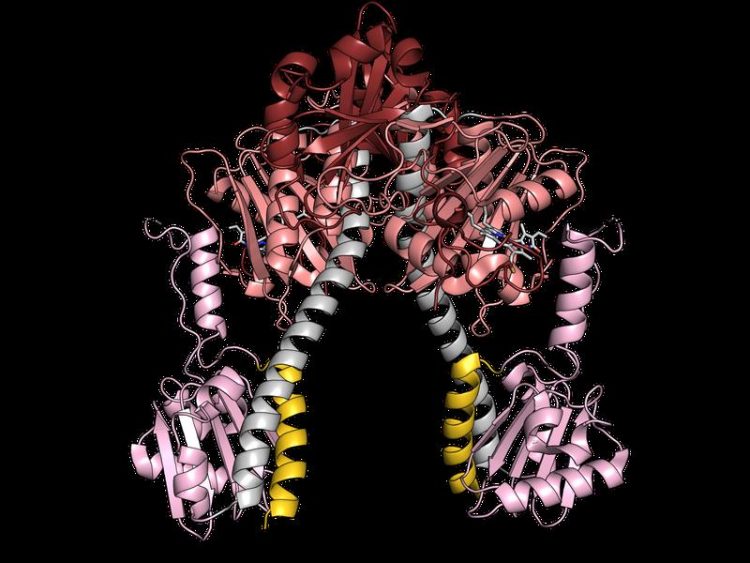Light controls brain cells: New EU project at the University of Bayreuth working towards therapy for neuronal disorders

Example of a phytochrome photoreceptor. Image: Andreas Möglich
It has long been known that the cerebral cortex of humans contains particular nerve cells classified as projection neurons. Once these cells are active, they influence networks of nerve cells located in deeper layers of the brain.
This is where important signal transmissions can be interrupted or delayed, for example, as a result of disease or injury. With the aim of gently eliminating or mitigating such disturbances, precisely targeted projection neurons in the cerebral cortex will in future be activated by laser light.
To this end, the researchers involved in the NEUROPA project plan to develop new types of phytochrome photoreceptors. Phytochromes are proteins that can be switched back and forth between two states: The wavelength of the light to which they are exposed determines their activity and thus the impulses they themselves emit to their environment.
The new phytochromes to be developed will be controlled by compact lasers so that that they in turn activate projection neurons in the cerebral cortex to a desirable extent. A better understanding of irregularities in signal transmission in deeper layers of the brain should in this way be attained, and in future also alleviated.
But how will the laser-directed phytochromes reach therapeutically suitable sites in the cerebral cortex? It would certainly be possible to inject the phytochromes into the cerebral cortex through the skullcap. However, the NEUROPA project hopes to avoid such invasive methods and instead develop an innovative, non-invasive solution.
In the future, the findings and methods of genetic engineering will ensure that the phytochromes form on their own at suitable sites in the cerebral cortex. Moreover, the micrometer wavelength laser beams used will be able to pass through the skullcap.
“Our European joint project is doing pioneering work in this still young field of research. Together with our partners, we intend to bring together new findings from optogenetics, photonics, and neurology in order to develop novel approaches in the development of gentle therapies of nerve networks in the brain.
This is particularly true with regard to severe neurodegenerative diseases such as Alzheimer's or Huntington's chorea,” says Prof. Dr. Andreas Möglich, Professor of Biochemistry at the University of Bayreuth. His research group has many years of experience in the field of photoreceptors and over this time has earned international recognition with publications in the field of optogenetics.
International research partners and research funding
Six partner institutions are working together in the NEUROPA joint project: the University of Bayreuth, Aston University Birmingham, the University of Oulu, the University of Barcelona, Sorbonne University in Paris, and Pharmacoidea Ltd in Szeged. NEUROPA is funded by the European Union, as part of “Horizon 2020”, as an FET Open Project (Future and Emerging Technologies). Projects of this kind are very competitive and aim to further develop highly innovative and technologically sophisticated research ideas that will bring beneficial applications for the economy and society into easy reach.
Prof. Dr. Andreas Möglich
Biochemistry
University of Bayreuth
Telephone: +49 (0)921 / 55-7835
E-Mail: andreas.moeglich@uni-bayreuth.de
Media Contact
More Information:
http://www.uni-bayreuth.de/All latest news from the category: Life Sciences and Chemistry
Articles and reports from the Life Sciences and chemistry area deal with applied and basic research into modern biology, chemistry and human medicine.
Valuable information can be found on a range of life sciences fields including bacteriology, biochemistry, bionics, bioinformatics, biophysics, biotechnology, genetics, geobotany, human biology, marine biology, microbiology, molecular biology, cellular biology, zoology, bioinorganic chemistry, microchemistry and environmental chemistry.
Newest articles

First-of-its-kind study uses remote sensing to monitor plastic debris in rivers and lakes
Remote sensing creates a cost-effective solution to monitoring plastic pollution. A first-of-its-kind study from researchers at the University of Minnesota Twin Cities shows how remote sensing can help monitor and…

Laser-based artificial neuron mimics nerve cell functions at lightning speed
With a processing speed a billion times faster than nature, chip-based laser neuron could help advance AI tasks such as pattern recognition and sequence prediction. Researchers have developed a laser-based…

Optimising the processing of plastic waste
Just one look in the yellow bin reveals a colourful jumble of different types of plastic. However, the purer and more uniform plastic waste is, the easier it is to…



